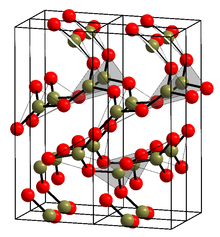![Crystal structure of B2O3 [1]](http://upload.wikimedia.org/wikipedia/commons/thumb/d/d9/B2O3powder.JPG/220px-B2O3powder.JPG)
| |

| |
| Names | |
|---|---|
| IUPAC name
Diboron trioxide
| |
| Other names
boron oxide, diboron trioxide, boron sesquioxide, boric oxide, boria
Boric anhydride | |
| Identifiers | |
3D model (JSmol)
|
|
| ChEBI | |
| ChemSpider | |
| ECHA InfoCard | 100.013.751 |
| EC Number |
|
| 11108 | |
PubChem CID
|
|
| RTECS number |
|
| UNII | |
CompTox Dashboard (EPA)
|
|
| |
| |
| Properties | |
| B2O3 | |
| Molar mass | 69.6182 g/mol |
| Appearance | white, glassy solid |
| Density | 2.460 g/cm3, liquid; 2.55 g/cm3, trigonal; |
| Melting point | 450 °C (842 °F; 723 K) (trigonal) 510 °C (tetrahedral) |
| Boiling point | 1,860 °C (3,380 °F; 2,130 K) ,[2] sublimes at 1500 °C[3] |
| 1.1 g/100mL (10 °C) 3.3 g/100mL (20 °C) 15.7 g/100mL (100 °C) | |
| Solubility | partially soluble in methanol |
| Acidity (pKa) | ~ 4 |
| −39.0·10−6 cm3/mol | |
| Thermochemistry | |
Heat capacity (C)
|
66.9 J/(mol⋅K) |
Std molar
entropy (S⦵298) |
80.8 J/(mol⋅K) |
Std enthalpy of
formation (ΔfH⦵298) |
−1254 kJ/mol |
Gibbs free energy (ΔfG⦵)
|
−832 kJ/mol |
| Hazards | |
| Occupational safety and health (OHS/OSH): | |
Main hazards
|
Irritant[4] |
| GHS labelling: | |

| |
| Danger | |
| H360FD | |
| P201, P202, P281, P308+P313, P405, P501 | |
| NFPA 704 (fire diamond) | |
| Flash point | noncombustible |
| Lethal dose or concentration (LD, LC): | |
LD50 (median dose)
|
3163 mg/kg (oral, mouse)[5] |
| NIOSH (US health exposure limits): | |
PEL (Permissible)
|
TWA 15 mg/m3[4] |
REL (Recommended)
|
TWA 10 mg/m3[4] |
IDLH (Immediate danger)
|
2000 mg/m3[4] |
| Supplementary data page | |
| Boron trioxide (data page) | |
Except where otherwise noted, data are given for materials in their standard state (at 25 °C [77 °F], 100 kPa).
| |
Boron trioxide or diboron trioxide is the oxide of boron with the formula B2O3. It is a colorless transparent solid, almost always glassy (amorphous), which can be crystallized only with great difficulty. It is also called boric oxide[6] or boria.[7] It has many important industrial applications, chiefly in ceramics as a flux for glazes and enamels and in the production of glasses.
- ^ Cite error: The named reference
a1was invoked but never defined (see the help page). - ^ High temperature corrosion and materials chemistry: proceedings of the Per Kofstad Memorial Symposium. Proceedings of the Electrochemical Society. The Electrochemical Society. 2000. p. 496. ISBN 978-1-56677-261-7.
- ^ Cite error: The named reference
patnaikwas invoked but never defined (see the help page). - ^ a b c d Cite error: The named reference
PGCHwas invoked but never defined (see the help page). - ^ "Boron oxide". Immediately Dangerous to Life or Health Concentrations (IDLH). National Institute for Occupational Safety and Health (NIOSH).
- ^ Cite error: The named reference
mccu1937was invoked but never defined (see the help page). - ^ Cite error: The named reference
vish2015was invoked but never defined (see the help page).
